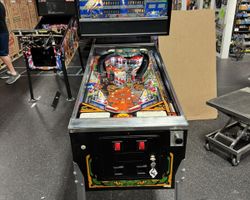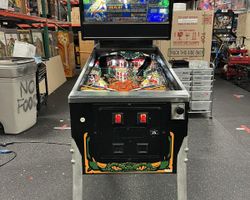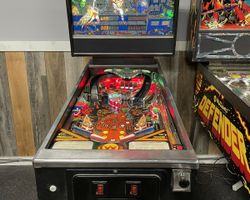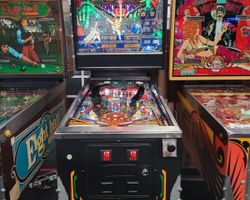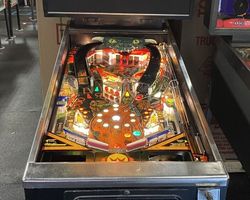Grand Lizard

Average Prices: USD $300 to $1,700
Produced: April, 1986
Production Run: 2,750 units
Machine Type: Solid State Electronic
MPU: Williams System 11
Players: 4
Design by: Barry Oursler, Python Anghelo
Art by: Paul Faris, Python Anghelo
Sound by: Bill Parod
Software by: Ed Suchocki
Williams Electronic Games, Inc. launched "Grand Lizard" in April 1986, a solid-state electronic pinball machine that emerged as one of the early titles to utilize the innovative System 11 platform. This game transported players into a primordial jungle, a realm dominated by a formidable reptilian creature. The theme, steeped in adventure, fantasy, and the allure of monstrous inhabitants, captivated players with its distinct atmosphere.
The creative genesis of "Grand Lizard" involved a collaborative team of designers and artists. Barry Oursler, known for his ability to craft engaging layouts, helmed the design alongside Python Anghelo, whose artistic vision often pushed the boundaries of pinball aesthetics. The initial playfield and backglass artwork were conceived by Paul Faris, a prolific artist in the industry. However, during the production phase, a significant artistic revision occurred: the backglass was redesigned to accommodate the new alphanumeric displays of System 11, with Python Anghelo providing the final artwork that defined the machine's visual identity. The sound design, a critical component of the game's immersive experience, was undertaken by Bill Parod. Notably, "Grand Lizard" marked a technical milestone for Williams, as it was the first game to incorporate digitized audio samples for its background music, a technique Parod would refine further in subsequent titles. Software development was managed by Ed Suchocki. With a production run of 2,750 units, "Grand Lizard" offered a unique experience that foreshadowed the capabilities of Williams's next generation of pinball machines. An interesting historical note lies in its model number, '523', which seemingly places it within the earlier System 7 era, despite being a definitive System 11 game. Furthermore, "Grand Lizard," like two other early System 11 machines, featured an enduring error in its schematics, depicting the flipper end-of-stroke switch on the incorrect side of the coil, though factory-wired units were always correct.
Signature Features and Design
"Grand Lizard" distinguishes itself through several unique elements that contribute to its gameplay and visual appeal. Foremost among these is the imposing plastic lizard head, perched atop the intersection of the machine's two main ramps. This creature serves as more than just a static prop; it is an active element that comes to life when a ball enters its maw. The lizard roars, its eyes flash, and the ball is returned to the playfield from its tongue, creating a moment of engaging interaction. This toy effectively grounds the game in its jungle theme, making the central monstrous presence a tangible part of the experience.
Another defining feature is the player-controlled Magna-Save. Positioned on the left outlane, this magnet allows players to briefly save a draining ball by activating it at a crucial moment. This mechanic introduces a direct skill shot element, demanding quick reflexes and precise timing from the player to prevent an early game over. The inclusion of two distinct ramps contributes to the game's overall flow, providing high-scoring shot opportunities and a visually dynamic playfield. With four flippers, including a pair of upper playfield flippers, "Grand Lizard" encourages varied shot angles and strategic ball control, enhancing the depth of its gameplay. The game's emphasis on drop targets, specifically seven of them, provides additional objectives and scoring avenues, a contrast to the absence of traditional pop bumpers, which shapes the playfield's ball movement.
Playfield and Mechanics
The "Grand Lizard" playfield presents a spacious and fast-paced environment, designed for high-energy play. Its layout features an open lower playfield, inviting rapid ball movement and strategic flipper control. The prominent feature, a pair of intersecting plastic ramps, defines much of the upper playfield flow. One ramp ascends towards the lizard's head, serving as a primary shot to activate the creature feature and initiate specific scoring sequences. The other ramp, positioned strategically, feeds balls back to the upper flippers, facilitating continuous action.
Central to the playfield's mechanics are the seven drop targets. A three-bank of drop targets on the upper left, coupled with a four-bank on the right, offers challenging objectives. These drop targets are often timed, creating a mini-game within the larger play experience where players must clear them quickly for maximum reward. The upper playfield, accessible via the upper flippers, features its own set of targets and pathways, ensuring that skilled players are rewarded for precision shots into this elevated zone. The playfield's artwork, primarily by Paul Faris, establishes the jungle aesthetic with lush green tones, ancient ruins, and reptilian motifs, creating a consistent visual narrative. Lighting is used effectively to highlight active shots and progression, particularly around the ramps and the lizard head, which pulsates with light during its animation. The aesthetic is cohesive, immersing players in a vibrant, untamed world. The overall layout shares conceptual similarities with earlier Williams titles like "Solar Fire" and "Black Knight," particularly in its two-level structure and emphasis on ramp shots, guiding ball flow through its distinct pathways.
Gameplay Dynamics
"Grand Lizard" offers a straightforward yet engaging gameplay progression that rewards both accurate shooting and strategic ball control. The core objective often revolves around activating and repeatedly hitting the ramps, which not only feed the ball to the lizard head but also contribute to building bonus multipliers and mystery scores. The timed drop targets introduce a layer of pressure; clearing these banks within the allotted time is crucial for advancing objectives and maximizing points. This element transforms what might be simple target shooting into a focused, high-stakes endeavor, demanding precise shots under duress.
Multiball is a central feature, typically initiated by locking balls through specific shots, often involving the ramps or drop targets. The game supports a three-ball multiball, which, while capable of ending quickly if not managed, offers significant scoring potential. A key strategy during multiball is to repeatedly hit the ramps and the drop targets, as these often light up for increased scoring during this phase. The Magna-Save, positioned strategically on the left outlane, serves as a crucial defensive maneuver. Mastering its timing, activating it just as a ball is about to drain, can extend ball times and provide opportunities to reset and re-engage with scoring objectives. Though the ruleset is comparatively simple by modern standards, its emphasis on fundamental pinball skills—shot accuracy, flipper control, and quick decision-making—makes it accessible yet challenging. Scoring is primarily driven by repeating key shots and completing target banks, culminating in high scores for sustained play and successful multiball sequences. The "mystery bonus" awarded for ramp shots adds an element of unpredictability and excitement, providing varying rewards from extra points to special features.
Reception and Legacy
"Grand Lizard" has garnered a generally positive reception within the pinball community, often celebrated for its fast, fluid gameplay. Players frequently praise its engaging flow, which encourages continuous ball movement across the playfield, particularly through its two ramps. The upper playfield, with its distinct targets and flippers, is often highlighted as a well-designed area that rewards precision. The 3-ball multiball, while straightforward, is regarded as fun and offers opportunities for high scoring, especially with the ability to "steal" locked balls. The player-controlled Magna-Save is consistently lauded as a popular and skillful feature, adding a layer of player interaction not commonly found in all machines of its era. The jungle theme, combined with Bill Parod's early digitized drum beats and animal sounds, creates a unique atmosphere that many find immersive and enjoyable. The light show, especially when shots reach the lizard head, is also frequently cited as a captivating element.
However, "Grand Lizard" is not without its criticisms. The backglass artwork, despite Python Anghelo's final touch, is a frequent point of contention, often described as visually jarring or rushed. Some players also find the cabinet art to be less vibrant than the playfield. Sonically, while the digitized drums were a technical innovation, their repetitive nature can become tiresome for some players during extended sessions. Gameplay can occasionally be perceived as repetitive due to the relatively simple ruleset, potentially leading to a sense of monotony for players seeking deeper objectives. The timed drop targets, while offering a mini-game, have been noted as requiring specific difficulty settings in competitive play to maintain challenge. Despite these criticisms, "Grand Lizard" holds a respectable position as an enjoyable and often underrated machine. Its significance lies in its role as an early System 11 title, showcasing the platform's potential for enhanced sound, lighting, and gameplay complexity that would become hallmarks of Williams's success throughout the late 1980s. Its fast playfield and unique features, particularly the Magna-Save and interactive lizard toy, influenced subsequent designs, reinforcing the idea that player interaction and dynamic playfield elements could elevate the pinball experience.
Sponsored Links
 Ebay Listings
Ebay Listings
 Auction Results
Auction Results
| Cost | Location | Date |
|---|---|---|
| USD $1,995 |  California, United States California, United States |
10 October, 2025 |
| USD $3,000 |  North Carolina, United States North Carolina, United States |
15 September, 2025 |
| USD $3,888 |  Florida, United States Florida, United States |
20 June, 2025 |
| USD $2,300 |  Ohio, United States Ohio, United States |
22 February, 2025 |
| USD $1,600 |  Kentucky, United States Kentucky, United States |
16 August, 2024 |
| USD $3,889 |  Florida, United States Florida, United States |
06 August, 2024 |
| USD $1,825 |  Indiana, United States Indiana, United States |
06 July, 2024 |
| USD $2,800 |  Illinois, United States Illinois, United States |
01 June, 2023 |
| USD $4,000 |  Florida, United States Florida, United States |
25 December, 2022 |
| USD $3,400 |  Arizona, United States Arizona, United States |
11 December, 2022 |


Private Policy · Search Website · Contact Us
As an eBay Partner, we may earn a commission from qualifying purchases made through links on this site, at no additional cost to you.
All trademarks and copyrighted materials remain property of their respective owners. All other content copyright 2007 - 2025 Pinpedia.

